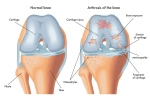All Things Cartilage Defects in the Knee: Do I need surgery?

Welcome to The Sports Docs Podcast with Dr. Catherine Logan and Dr. Ashley Bassett. On each episode we chat about the most recent developments in sports medicine and dissect through all the noise so you know which literature should actually impact your practice.
On today’s episode we’re focusing on cartilage defects of the knee with Dr. Clayton Nuelle, Assistant Clinical Professor at the University of Missouri and team physician for Mizzou athletics. His current research focuses on improving cartilage restoration and joint preservation techniques, so we are very excited to have him join us for our discussion today.
We have some great articles for you that contribute well to our conversation on the surgical treatment of knee cartilage disease.
The first article is a level I prospective RCT published in the May 2018 issue of AJSM titled “Matrix-Applied Characterized Autologous Cultured Chondrocytes Versus Microfracture – Five Year Follow-up of a Prospective Randomized Trial.” This multicenter study was performed at 14 sites across 7 different countries. Patients with symptomatic full thickness cartilage defects greater than 3 cm in size and involving the femoral condyle or trochlea were randomized to either the MACI procedure or microfracture procedure. If you’re not familiar with the MACI procedure, we definitely recommend checking out our last Overtime episode where we do a deep dive into the details of that surgical technique.
In this 5-year clinical trial, Brittberg and colleagues found that while both groups significantly improved after surgery, patients who underwent the MACI procedure were both clinically and statistically significantly better at 5 years compared to patients who underwent microfracture.
Then, from the February issue of AJSM this year, we review the publication titled “Isolated Osteochondral Autograft versus Allograft Transplantation for the Treatment of Symptomatic Cartilage Lesions of the Knee.” Bryan Saltzman and his team at OrthoCarolina performed a systematic review of Level I and II studies investigating osteochondral transplant techniques. For our listeners, osteochondral transplants can be performed using autograft – the patient’s own tissue, or allograft – donor tissue. Traditionally, autograft transplant or “OATs” has been used for smaller defects, to minimize donor-site morbidity, and has the benefits of avoiding an immune response and no concern for disease transmission.
The osteochondral graft is typically harvested from nonweightbearing areas of the knee, such as the intercondylar notch or supracondylar ridge. Allograft transplant or “OCA” is indicated for larger defects. Benefits include the lack of donor site morbidity and the ability to take a graft from an area that correlates with the defect being addressed, such as patella to patella. Grafts can also be size-matched during the ordering process. Downsides include having to wait for allograft availability and cost, in addition to the immunologic and disease transmission risks already discussed, though those are very rare. Both techniques have the benefit of addressing not only the cartilage disease but also underlying bone loss.
This systematic review concluded that both OATs and OCA resulted in favorable patient outcomes and graft survival rates at 5-year follow up, with no significant differences between the two. The autograft group was significantly younger, had smaller defect size, used a larger number of plugs and more frequently treated medial femoral condyle lesions. The allograft group had a larger number of patients with lateral femoral condyle and trochlear lesions.



